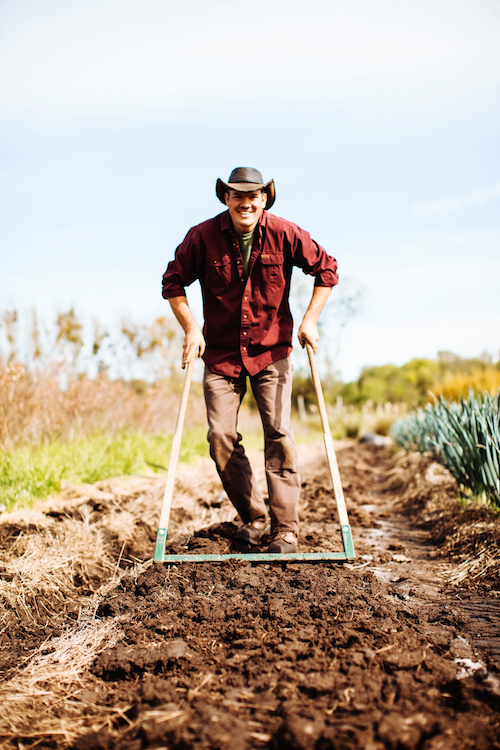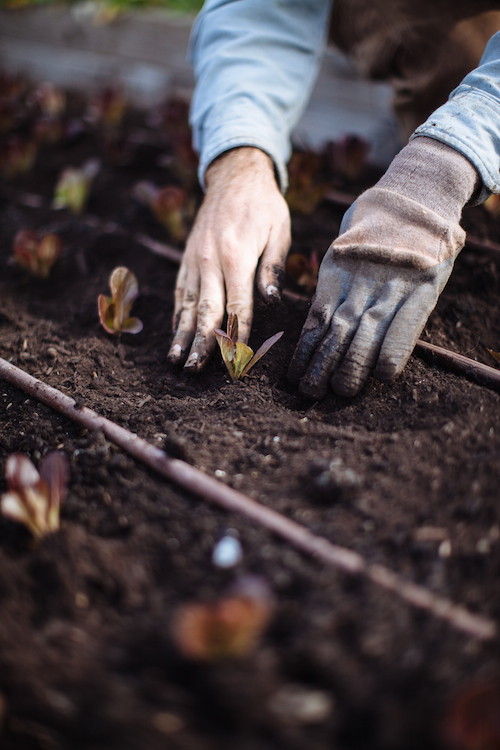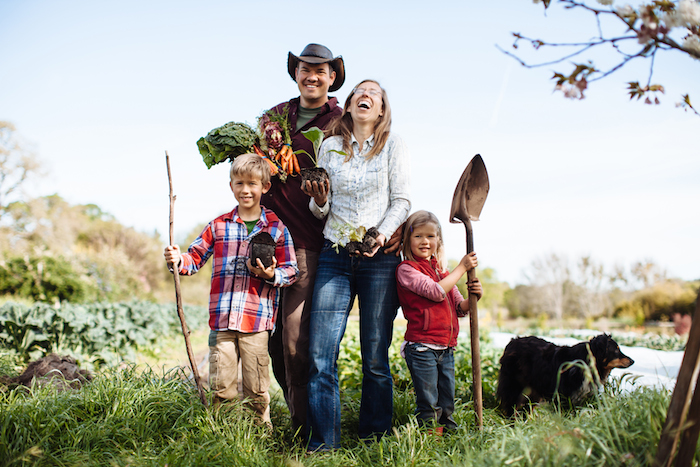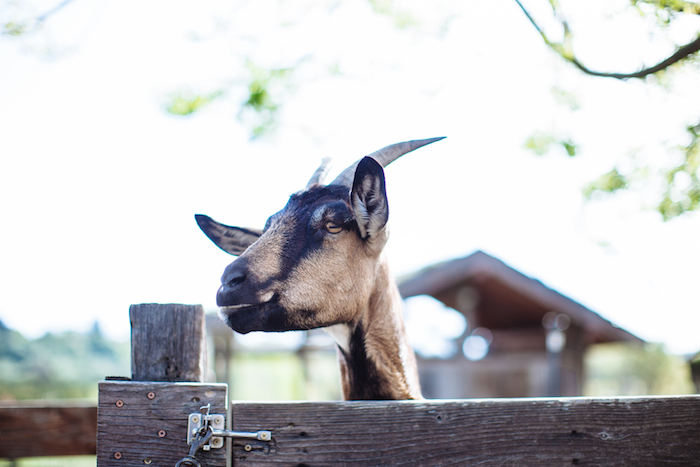Singing Frogs Farm and the great no-till, mega-compost experiment.
Editor’s note: This excerpt adapted with permission from ‘The Drought Fighter,’ originally published in ‘Craftsmanship Magazine.’
The complete article can be found online at craftsmanship.net/drought-fighters
One March afternoon in 2014, on Singing Frogs Farm, the small vegetable farm that Paul Kaiser runs in Sebastopol, a group of agriculture specialists gathered around a four-foot steel pole. The experts had come to test the depth and quality of Kaiser’s topsoil, and one of them, a veteran farmer from the Central Valley named Tom Willey, leaned on the pole to push it into the dirt as far as he could. On a typical farm, the pole comes to a stop against infertile hard-pan in less than a foot.
But in Kaiser’s field, the pole’s entire length slid into the ground, and Willey almost fell over. “Wow, that’s incredible,” he said, wondering if he’d hit a gopher hole. The whole group burst out laughing. “Do it again! Do it again!” said Jeff Mitchell, a longtime professor of agriculture at the University of California at Davis.
The group repeated the exercise, over and over—for photo ops, and to make sure that Kaiser really had accomplished the various feats he talks about, which he does almost incessantly these days. It’s not the easiest sell.
Kaiser and his wife Elizabeth farm a mere eight acres, and harvest fewer than three of them. Nonetheless, his methods are at the forefront of a farming movement that is so new, at least in the U.S., and so built for a climate-changed world of diminishing rains that it opens up gargantuan possibilities. One might call this methodology sustainability on steroids, because it can generate substantial profits. Last year, the Kaisers’ farm grossed more than $100,000 an acre, which is 10 times the average per-acre income of comparable California farms, including vineyards.
The Kaisers manage all of this without plowing an inch of their ground, without doing any weeding, and without using any sprays—either chemical or organic. And while most farmers, even on model organic farms, constantly tinker with various fertilizer cocktails, the Kaisers concentrate on just one: a pile of rotten food and plants, commonly known as compost, and lots of it. The Kaisers add this compost to a rare blend of farming practices, both old and new, all aimed at returning dirt to the richest, most fertile seedbed possible. “It’s unique,” Mitchell told me after his visit. “I’ve never seen anything approaching that kind of thing.”
On some of the big organic farms, the soils are incredibly destroyed,” Ray Archuleta, an agronomist with the U.S. Department of Agriculture, recently told me. The reason Archuleta gave me is almost counterintuitive: While they do avoid chemicals, most organic farmers still resort to what are essentially artificial methods of cultivation, based largely on tearing up the ground with discs and spaders, the same way conventional farmers do, then abandoning it until the next season. They also use too much water.
As an illustration of Archuleta’s point, in the five years since Kaiser stopped plowing his fields, his irrigation levels have dropped by more than half, to as little as an hour a week, with production steadily increasing. He now irrigates almost exclusively with a drip system, through thin plastic tubes; meanwhile, some of his organic neighbors still run sprinklers, which require massive amounts of water, much of which is lost almost immediately through evaporation.
This is a big deal. As everyone knows, California is amid an historic drought, and it just finished its hottest year on record. But sparse rainfalls simply highlight, and aggravate, a problem that has been accumulating for decades: the steady thinning out of America’s topsoil. “I never thought I would see the Dust Bowl again,” Archuleta says. “We’ve spent trillions of dollars and we’re still in the same place. What’s going on?”
Doomsayers have been warning about soil abuse since the dawn of agriculture. We have also known how its fertility gets rebuilt ever since 1882, when Charles Darwin published one of his more obscure discoveries: topsoil is created by none other than the lowly earthworm, at a rate of 10 to 20 tons per acre each year. But if that soil is beaten into the dusty powder that has become increasingly common across the globe, there is nothing in it anymore for the worms—or, by extension, for the rest of the earth’s ecosystem.
During the last few decades, soil scientists have found that this ecosystem is far more extensive than anything yet seen on land or in the sea. Some have counted more organisms in a teaspoon of soil than there are human beings on the planet. Others, such as Noah Fierer, a professor specializing in microbial ecology at the University of Colorado, have found the biodiversity of soil to be so vast that it defies tabulation through today’s DNA tests. When examined under a microscope, the dirt in that teaspoon looks like a cross between an Amazon jungle and some exotic, tropical coral reef teeming with seaweed, plankton, and monstrous creatures from a Jules Verne novel.
As all these invisible creatures collaborate, they strengthen the soil to hold water; withstand erosion; store and feed the plants nutrients; help build their immune systems; and, preliminary research suggests, stimulate symbiotic microbes in the human gut as we eat these plants, which strengthens our immune systems, too.
Considering all this activity, Kaiser, like a growing number of his peers, cannot understand the way we’ve treated the world beneath our feet. “What creates life?” Kaiser asks. “Sun, rain, and soil. We can only impact one of these: soil. It’s the only thing on the planet that takes death and converts it back to life. And all we’ve done is destroy it.”
In 2007, the Kaisers began farming the Singing Frogs property using whatever tools they had inherited in the farm’s purchase, plowing the ground like every other farmer does. The place had gone uncultivated for years, and simple weed growth had already banked the land with some pent-up fertility. So the farm quickly blossomed. But so did the labor. “The weeds were immense,” Kaiser says. “We were out there at night, with head lamps, weeding for hours!”
Then one spring morning, he saw a mother killdeer screeching at his tractor. After a few more passes up and down the field, he realized she was protecting her eggs, which were nesting invisibly in the ground. When Kaiser stopped to inspect, he noticed all kinds of damage in the wake of his plow—cut up worms and snakes, damaged beehives, valuable roots and bug colonies exposed to the hot sun. Some months later, after getting his thumb mangled in his tractor’s engine, he had an epiphany: “I am not doing this anymore,” he recalls thinking. “There has got to be a better way.”
In his studies, Kaiser had noticed a prodigious amount of literature extolling the virtues of “no-till” agriculture—in other words, farming without using machines such as a plow or spader to turn over the ground. The practice follows the second often-ignored rule of cultivation: disturb your soil as little as possible. Yet no-till farming has a surprisingly mixed record.
On the positive side, leaving old crops behind feeds the soil with a variety of crucial nutrients, as the plants decompose into rich compost; the roughage also minimizes water evaporation, erosion, and the array of hidden damage that both cause. The federal government has been plenty blunt about this. In a 2010 report, the USDA said, “Tilling the soil is the equivalent of an earthquake, hurricane, tornado, and forest fire occurring simultaneously to the world of soil organisms.” Don Tyler, a USDA conservation specialist, has argued that one year of tillage can undo 25 years of an untilled farm’s soil improvement.
Last year, Singing Frogs Farm grossed more than $100,000 an acre, which is 10 times the average per-acre income of comparable California farms, including vineyards.
But no-till has its negative side, too: If fields aren’t managed with special care, no-till farming can lower productivity. It also tends to involve more pesticides and herbicides than does tillage because the vegetation left behind has to be dealt with in some way. Ironically, this is especially true when no-till farmers try, during the off-season, to create more fertility by planting cover crops.
Kaiser is fanatical about following what he calls the three main rules of soil health: Keep roots in the ground as much as possible. Keep the soil covered as much as possible. And disturb the soil as little as possible. To that end, Kaiser may plow a field once when first reviving old land for planting. After that, he never plows it again. If a crop bed eventually needs some aeration, the most he will do is poke at it with a hand-spader.
To most farmers, a routine like this involves too much muddy trouble and demands too much from their soil. Actually, they’ve got it backwards. The more that crops remain in the ground, the happier the dirt is—because all worms and microbes depend on plant roots for their food. This casts a new light on the myriad fields across the country that are disked and left fallow every winter. They aren’t resting; they’re dying.
Then Kaiser tried another experiment: Instead of following the standard procedure of mixing a little fertilizer into his fields, he laid a thick layer of compost right on top. The choice had its risks. Compost is essentially nature’s version of a reduction sauce: dense, rich, a potent blend of vegetation’s essences. Despite its liveliness, this material can be too much for young crops, burning their tender shoots. With a little more reading, Kaiser discovered that he could neutralize his compost with calcium (from crushed oyster shells) and trace minerals (from rock powder). So he layered on the entire mess and planted straight through it.
Thanks to the nutrient balance in his new dirt, the family’s seedlings, which were already robust, got an extra head start. “Our crops out-compete the weeds from the get-go,” Kaiser says. “So we just got rid of the weeding.” As one of Singing Frogs’ employees, John Cheatwood, puts it, “The compost is our equivalent of roto-tillers and spaders.” This high-intensity cycle—compost, transplant, harvest, repeat—has allowed Kaiser to produce up to seven crops of vegetables per acre every year. This is three to five times what most farms produce. What’s not to love about that?
Compost, it turns out, is a complicated creature. On one hand, its rich ingredients stimulate crop growth so effectively that one can’t help wondering why more farmers don’t make greater use of it. “We just don’t have the carbon,” says Ray Archuleta of the USDA. Archuleta is mainly referring to the gap between current compost supplies and the 920 million acres currently planted with crops in this country; but he’s also calling compost “carbon” for provocative reasons.
Carbon is bad, right? As it transforms into carbon dioxide, it’s the main cause of climate change. (The same goes for nitrogen as it becomes nitrous oxide, a greenhouse gas nearly 300 times as potent as carbon dioxide.) Well, carbon and nitrogen also are the primary ingredients in compost; and, by extension, in the fertile elements of topsoil. So these chemicals are bad only if we put them in the wrong place—in our air, when they should be going back into the ground.
On the other hand, compost has its ugly side. Due to the world’s ceaseless pressure for more American crops, farmers everywhere have become addicted to nitrogen. Most nitrate poisoning comes from storm water run-off from livestock feedlots, and from factory farms, which use abundant amounts of synthetic nitrogen fertilizers. Plenty comes from simple compost, however, which is typically loaded with nitrogen.
Strangely, organic farmers, who love compost, tend to be among the worst nitrate polluters. Kaiser fertilizes his crops with unusually large amounts of compost — more than 60 tons per acre every year. This is five to 10 times more compost than most farmers use. While Kaiser also grows more crops than the average farmer, recent tests indicate that his compost might be providing more nutrients than the crops need. When excesses exist for some of those nutrients—primarily nitrogen, phosphorus, and several trace metals—they become toxic, both to water supplies and to those who eat the farmer’s crops. Creating more precise methods for controlling a field’s nutrient levels is therefore a crucial challenge facing Kaiser, and any other farmer practicing his intensive techniques.
Kaiser’s soil tests do show some moderately high levels of nitrate and even higher levels of phosphate. But his storm water tests—which agronomists consider the gold standard for testing whether fertilizers are “leaking” from a farm—are almost crystal clear.
How can that be? If you listen to agronomists and soil scientists who are skeptical of Kaiser’s methods, it’s because these pollutants often hide out. There is some evidence that this might be true, and there is some evidence that it isn’t.
If you listen to Kaiser, however, the lab technicians are missing the truth. The pollutants aren’t visible simply because all of the biological life that he has built up in his fields is eating them up.
“The high organic matter buffers any inconsistency in those nutrients,” Kaiser says. “It sounds like all these criticisms are coming from people who don’t understand a truly biological system.” As audacious as that claim may sound, Kaiser has a few scientists on his side, too. “All that microbial life is just cycling through those nutrients,” says Jerry Hatfield of the USDA. Ray Ward, a leading soil testing expert, agrees. Jeff Creque, chief scientist of the Marin Carbon Project, stands by Kaiser’s methods as well. Creque further argues that industrial agriculture’s departure from biological systems is what led to much of our troubles with carbon dioxide pollution in the first place.
The problem is that no matter how credentialed any of these observers are, to a large extent they are just guessing. Nitrogen and phosphorus are just two of the billions of ingredients, both elemental and alive, that create something called soil. Scientists have only recently begun to understand how this ecosystem affects fertility as its micro-inhabitants interact. Thomas F. Morris, a plant sciences professor at the University of Connecticut who specializes in soil fertility, perhaps put it most succinctly. “We know less about the soil,” he told me, “than we do about the moon.”
Article Resources:
Read the entirety of Todd Oppenheimer’s most excellent article at craftsmanship.net/drought-fighters




